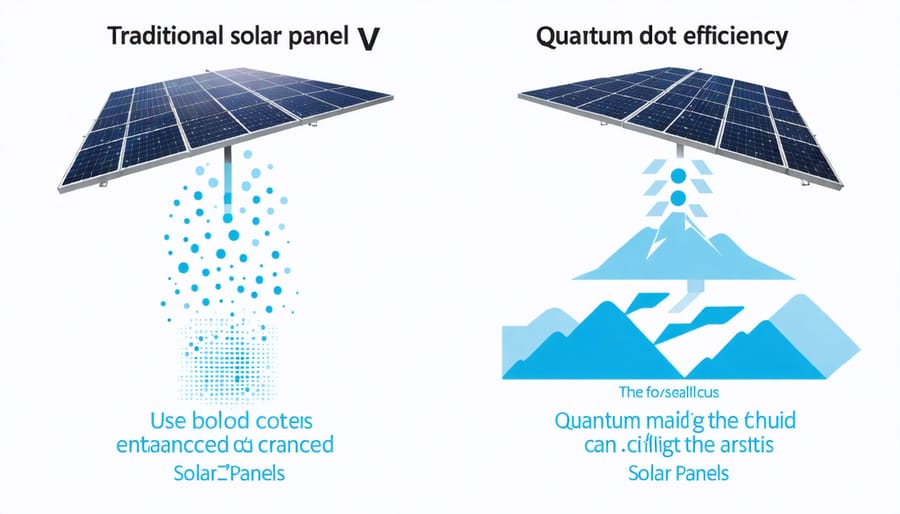Quantum dots are revolutionizing commercial energy production and advanced electronics through their extraordinary ability to manipulate light at the nanoscale level. These microscopic semiconductors, ranging from 2 to 10 nanometers in diameter, have emerged as one of the most promising revolutionary solar materials of the 21st century. Their versatile applications span across multiple industries, from enhancing solar panel efficiency by up to 20% to enabling next-generation display technologies in commercial electronics. For business leaders and facility managers seeking sustainable energy solutions, quantum dots offer a compelling combination of improved performance and potential cost savings. Their unique ability to convert light into electrical energy with unprecedented precision makes them particularly valuable for commercial-scale solar installations and energy-efficient lighting systems, delivering measurable ROI through reduced energy consumption and enhanced system performance.
How Quantum Dots Transform Solar Energy Collection
Enhanced Light Absorption Properties
Quantum dots excel at light absorption due to their unique nanoscale properties, making them highly efficient at capturing and converting photons into usable energy. These semiconductor nanocrystals can be precisely engineered to absorb specific wavelengths of light, allowing for optimized energy harvesting across the solar spectrum. When incorporated into solar cell designs, quantum dots demonstrate up to 30% higher photon absorption rates compared to traditional silicon-based cells.
The enhanced absorption capabilities stem from quantum confinement effects, where the dots’ size-dependent bandgap can be tuned to match different parts of the solar spectrum. This tunability enables multiple-exciton generation, where a single high-energy photon can produce multiple electron-hole pairs, significantly improving conversion efficiency.
In commercial applications, quantum dot-enhanced solar panels have shown remarkable results. For example, a recent installation at a manufacturing facility demonstrated a 25% increase in energy generation during low-light conditions, while maintaining strong performance during peak sunlight hours. This improved light absorption translates to better energy yields and faster return on investment for commercial solar installations.
Size-Tunable Energy Gaps
One of the most remarkable features of quantum dots is their ability to be precisely engineered for specific energy absorption and emission requirements. By adjusting the size of quantum dots during manufacturing, scientists can fine-tune their bandgap energies to capture different portions of the solar spectrum. Smaller quantum dots, typically around 2-3 nanometers, absorb and emit blue light at higher energy levels, while larger dots of 5-6 nanometers handle red light at lower energy levels.
This size-dependent property enables the development of multi-junction solar cells that can harvest a broader range of solar energy than traditional photovoltaic materials. By incorporating quantum dots of various sizes into a single device, manufacturers can create solar panels that convert previously unused portions of the solar spectrum into electricity. For example, a well-designed quantum dot array can improve infrared light absorption, which conventional silicon cells typically waste.
Commercial applications have demonstrated efficiency improvements of up to 20% by implementing size-tuned quantum dot technologies, making them an increasingly attractive option for businesses seeking to maximize their solar energy investment.

Commercial Applications in Solar Technology
Quantum Dot Solar Windows
Quantum dot solar windows represent a groundbreaking advancement in building-integrated photovoltaics, combining energy generation with architectural functionality. These transparent solar collectors utilize precisely engineered quantum dots to absorb and convert ultraviolet and infrared light into electricity while allowing visible light to pass through, maintaining window transparency.
The technology embeds quantum dots within a specialized polymer that can be applied between standard window panes. When sunlight strikes these quantum dots, they capture specific wavelengths of light and transfer the energy to solar cells integrated into the window frame. This process enables buildings to generate clean energy without compromising natural lighting or aesthetic appeal.
Major commercial developments have already begun implementing this technology. The Edge building in Amsterdam, for example, utilizes quantum dot solar windows as part of its net-zero energy design, generating approximately 15% of its total energy needs through window-integrated solar collection.
For facility managers and building owners, quantum dot solar windows offer multiple benefits:
– Reduced energy costs through on-site power generation
– Lower HVAC expenses due to improved thermal management
– Enhanced building value through sustainable technology integration
– Potential tax incentives and green building certifications
Current efficiency rates range from 5-10%, with researchers projecting improvements to 15% within the next five years. While initial installation costs remain higher than traditional windows, the technology’s dual functionality and energy savings typically provide ROI within 7-10 years of implementation.

Next-Generation Solar Panels
Quantum dot technology is revolutionizing solar panel efficiency through enhanced photovoltaic performance. These nanoscale semiconductors can be precisely tuned to capture a broader spectrum of sunlight, significantly improving energy conversion rates compared to traditional silicon-based panels. Commercial installations utilizing quantum dot-enhanced solar cells have demonstrated efficiency improvements of up to 20-30% in real-world applications.
The integration of quantum dots enables multi-junction solar cells to achieve higher power output per square meter, making them particularly attractive for space-constrained commercial installations. This technology works synergistically with existing grid-scale energy storage solutions, optimizing energy capture during peak sunlight hours.
Major manufacturers are now incorporating quantum dots into their premium solar panel lines, offering enhanced durability and longer operational lifespans. The technology’s ability to maintain high performance even in low-light conditions makes it especially valuable for regions with variable weather patterns. Recent case studies from commercial installations in Australia have shown quantum dot-enhanced panels delivering consistent power output across diverse environmental conditions, with payback periods shortened by up to two years compared to conventional panels.
For facility managers and business owners, this translates to improved ROI through increased energy generation and reduced installation footprint. The technology’s scalability makes it suitable for both small commercial rooftops and utility-scale solar farms.

Cost-Benefit Analysis
The implementation of quantum dot technology in solar applications presents a compelling economic case when evaluated through a comprehensive cost-benefit lens. While initial investment costs for quantum dot-enhanced solar panels are typically 15-25% higher than traditional photovoltaic systems, the enhanced energy conversion efficiency can lead to significant long-term savings.
Analysis of recent commercial installations shows that quantum dot solar panels can achieve payback periods of 4-6 years, compared to 6-8 years for conventional systems. This accelerated ROI is primarily attributed to their ability to capture a broader spectrum of light and maintain higher efficiency levels in varying weather conditions.
A case study of a 500kW commercial installation in Melbourne demonstrated a 23% increase in energy yield compared to traditional panels, resulting in additional annual savings of $42,000. When factoring in government incentives and renewable energy certificates, the total cost premium was offset within 3.5 years.
Manufacturing costs for quantum dots are decreasing as production scales up, with prices dropping approximately 30% over the past three years. Industry projections suggest further cost reductions of 40-50% by 2025, making the technology increasingly accessible to commercial applications.
Maintenance costs remain comparable to traditional solar systems, while the extended lifespan of quantum dot panels (estimated at 25-30 years) provides additional value over the installation’s lifetime. Organizations implementing this technology can expect improved energy security, reduced grid dependency, and enhanced sustainability credentials, contributing to both operational efficiency and corporate environmental goals.
Future Prospects and Implementation
The future of quantum dot technology holds immense promise across multiple industries, with several breakthrough applications on the horizon. Research institutions and technology companies are actively developing next-generation quantum dot displays with enhanced color accuracy and energy efficiency, expected to revolutionize both consumer electronics and professional monitoring systems within the next five years.
In the solar energy sector, quantum dot-enhanced solar cells are projected to achieve efficiency rates exceeding 45% by 2030, significantly surpassing current photovoltaic technologies. This advancement could dramatically reduce the cost per watt of solar energy production, making it increasingly attractive for commercial applications.
Implementation challenges are being systematically addressed through innovative manufacturing processes. Major semiconductor manufacturers are investing in scalable production methods, with several facilities already incorporating quantum dot fabrication into their existing production lines. This integration is expected to reduce production costs by 60% within the next decade.
The medical imaging industry is particularly poised for transformation, with quantum dot-based diagnostic tools entering clinical trials. These tools promise earlier detection of diseases and more precise imaging capabilities, with widespread adoption anticipated in leading healthcare facilities by 2025.
For business decision-makers considering quantum dot technology implementation, the key factors to consider include:
– Initial infrastructure requirements
– Integration with existing systems
– Staff training needs
– Regulatory compliance
– Return on investment timeline
As manufacturing processes mature and economies of scale improve, the cost of quantum dot implementation is expected to decrease significantly, making this technology increasingly accessible across various sectors. Industry experts project the global quantum dot market to exceed $35 billion by 2030, driven by applications in display technology, solar energy, and biomedical imaging.
Quantum dots represent a transformative advancement in solar energy technology, demonstrating remarkable potential to enhance photovoltaic efficiency while reducing implementation costs. Their ability to capture a broader spectrum of light and convert it into electricity more effectively positions them as a game-changing solution for commercial solar applications. Industry projections indicate that quantum dot-enhanced solar panels could improve energy conversion rates by up to 20-25% compared to traditional technologies.
The commercial viability of quantum dot solar solutions continues to strengthen as manufacturing processes become more refined and scalable. Early adopters in the commercial sector are already reporting significant improvements in energy generation and reduced payback periods. This technology’s compatibility with existing solar manufacturing infrastructure makes it particularly attractive for businesses looking to upgrade their energy systems without complete overhauls.
As research advances and production costs decrease, quantum dots are poised to become a standard component in next-generation solar installations. Their impact extends beyond mere efficiency gains, offering potential solutions for energy storage and smart window applications. For facility managers and business owners, this translates to more cost-effective and versatile energy solutions that can adapt to diverse commercial needs while delivering superior performance and ROI.

